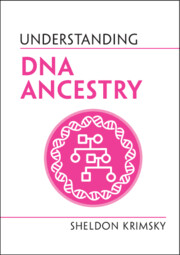Book contents
- Understanding DNA Ancestry
- Series page
- Understanding DNA Ancestry
- Copyright page
- Reviews
- Dedication
- Contents
- Foreword
- Acknowledgments
- 1 Introduction
- 2 The Business of DNA Ancestry
- 3 What Our Genomes Tell Us about the Geographical Origins and Movements of Early Human Populations
- 4 The Science behind DNA Ancestry Testing
- 5 Ancestry Informative Markers
- 6 Ancestry DNA Population Reference Panels
- 7 Comparing a Donor’s DNA to Reference Panel Populations
- 8 Probing Your DNA
- 9 Forensic Applications of Ancestry DNA Results
- 10 Privacy, Personal Identity, and Legal Issues
- 11 Discovering Unknown, Missing, or Mistaken Relatives
- 12 Accuracy, Consistency, and Validation of DNA Ancestry Tests
- 13 Conclusion
- Summary of Common Misunderstandings
- References
- Index
- Other books authored, coauthored, or coedited by Sheldon Krimsky
7 - Comparing a Donor’s DNA to Reference Panel Populations
Published online by Cambridge University Press: 05 March 2022
- Understanding DNA Ancestry
- Series page
- Understanding DNA Ancestry
- Copyright page
- Reviews
- Dedication
- Contents
- Foreword
- Acknowledgments
- 1 Introduction
- 2 The Business of DNA Ancestry
- 3 What Our Genomes Tell Us about the Geographical Origins and Movements of Early Human Populations
- 4 The Science behind DNA Ancestry Testing
- 5 Ancestry Informative Markers
- 6 Ancestry DNA Population Reference Panels
- 7 Comparing a Donor’s DNA to Reference Panel Populations
- 8 Probing Your DNA
- 9 Forensic Applications of Ancestry DNA Results
- 10 Privacy, Personal Identity, and Legal Issues
- 11 Discovering Unknown, Missing, or Mistaken Relatives
- 12 Accuracy, Consistency, and Validation of DNA Ancestry Tests
- 13 Conclusion
- Summary of Common Misunderstandings
- References
- Index
- Other books authored, coauthored, or coedited by Sheldon Krimsky
Summary
As we noted previously, the science behind DNA ancestry requires that one compares the unique genetic markers on the consumer’s DNA sample with the frequency of those markers in reference panels representing different regions of the world. When the field of DNA ancestry began, it was a scientific project that involved the search for biogeographical DNA. Scientists could use changes in the human genome to determine how ancient populations moved around the globe. The further populations moved across the globe and the more time elapsed (many thousands of years), the greater the number of mutations or genetic variants. Genetic ancestry began with a half-dozen distinct continental regions and with markers called hypervariable microsatellites, or short tandem repeats (STRs) of DNA, 2–6 base pairs in length. These microsatellites were considered ideal at the time because they had a high heterozygosity, which means two different alleles at a site. A site that has an AA is homozygous, whereas one that has AG is heterozygous. The more diverse the alleles, the greater the chance of distinguishing allele frequencies among populations. Initially, scientists used changes in the maternally inherited mitochondrial DNA (mtDNA) and the paternally inherited Y chromosome. That changed when autosomal markers were chosen for ancestry analysis.
Keywords
Information
- Type
- Chapter
- Information
- Understanding DNA Ancestry , pp. 60 - 72Publisher: Cambridge University PressPrint publication year: 2021
